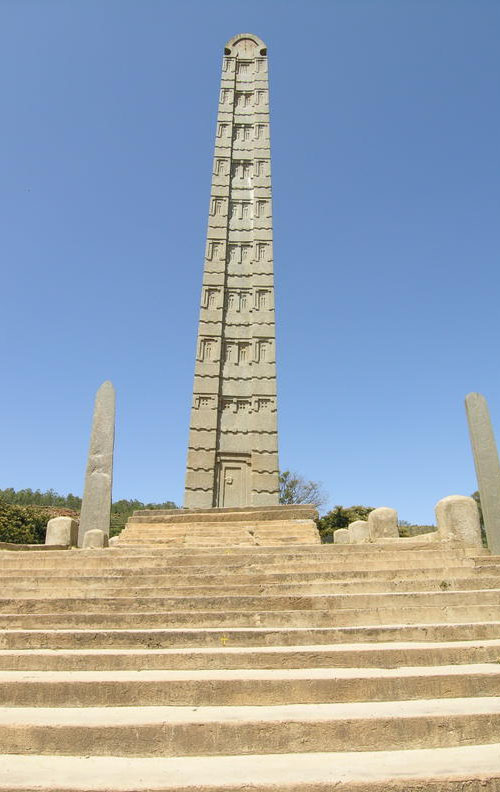The ruins of the ancient city of Aksum are found close to Ethiopia's northern border. They mark the location of the heart of ancient Ethiopia, when the Kingdom of Aksum was the most powerful state between the Eastern Roman Empire and Persia. The massive ruins, dating from between the 1st and the 13th century A.D., include monolithic obelisks, giant stelae, royal tombs and the ruins of ancient castles. Long after its political decline in the 10th century, Ethiopian emperors continued to be crowned in Aksum.

The obelisk -- properly termed a 'stele' or, in the local Afro-Asiatic languages, hawilt/hawilti (as it is not topped by a pyramid) -- is found along with many other stelae in the city of Axum in modern-day Ethiopia. The stelae were probably carved and erected during the 4th century A.D. by subjects of the Kingdom of Aksum, an ancient Ethiopian civilization. Erection of stelae in Axum was a very old practice (today it is still possible to see primitive roughly carved stelae near more elaborated "obelisks"), probably borrowed from the Kushitic kingdom of Meroe. Their function is supposed to be that of "markers" for underground burial chambers. The largest of the grave markers were for royal burial chambers and were decorated with multi-story false windows and false doors, while nobility would have smaller, less decorated ones. While there are only a few large ones standing, there are hundreds of smaller ones in various "stelae fields". The last stele erected in Axum was probably the so-called King Ezana's Stele, in the 4th century A.D.
The Obelisk of Axum in Rome in 2002, before its repatriation.
King Ezana (c.321 – c. 360), influenced by his childhood tutor Frumentius, introduced Christianity to Axum, precluding the pagan practice of erecting burial stelae (it seems that at the feet of each obelisk, together with the grave, there was also a sacrificial altar).
Over the course of time, many of these stelae fell to the ground[2] due to: structural collapse (as, probably, in the case of the Great Stele, measuring 33 m), possibly immediately after their erection; earthquakes (Axum is in a seismic zone); or the military incursions of the Imam Ahmad Gragn during the Ethiopian-Adal War from 1529-43. In the 19th century, of the three major "royal" stelae, only King Ezana's Stele remained erected, shown in the painting "Sight of Axum" of Henry Salt (1780–1827).
The Obelisk of Axum, was itself collapsed and broken when it was found by Italian soldiers at the end of 1935, following the Italian conquest of Ethiopia. It had fallen in the 4th century and had broken into five pieces.[3] In 1937, it was taken as war booty and moved to Italy by the Fascist regime, which wanted to commemorate the conquest of Ethiopia and the birth of the ephemeral "new Roman Empire" (see Italian Empire). The stele which were transported by truck along the tortuous route between Axum and the port of Massawa, taking five trips over a period of two months. It arrived via ship in Naples (on a boat called the Adua), on March 27, 1937. It was then transported to Rome, where it was reassembled and erected on Porta Capena square in front of the Ministry for Italian Africa (later the headquarters of the United Nations's Food and Agriculture Organization) and the Circus Maximus. It was officially unveiled on October 28 1937 to commemorate the 15th anniversary of the March on Rome.[4] The operation was coordinated by Ugo Monneret de Villard.
